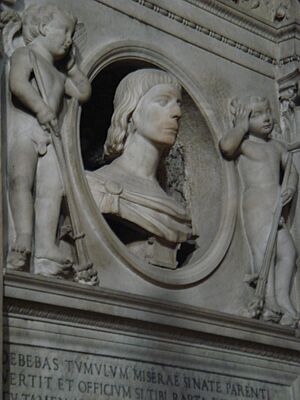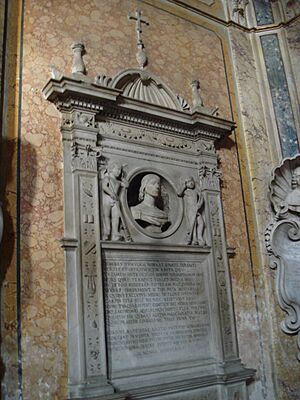Emilio de' Cavalieri facts for kids
Quick facts for kids
Emilio de' Cavalieri
|
|
|---|---|

Bust of Emilio de' Cavalieri
|
|
| Born | circa 1550 |
| Died | March 11, 1602 (aged 52) |
| Resting place | Cappella de' Cavalieri in Santa Maria in Aracoeli, Rome |
| Nationality | Italian |
| Occupation | Composer |
| Employer | Ferdinando de' Medici |
| Parent(s) |
|
Emilio de' Cavalieri (around 1550 – 11 March 1602) was an Italian composer, producer, organist, and even a diplomat and choreographer. He lived at the end of the Renaissance period. His work, along with others in Rome, Florence, and Venice, helped start the Baroque era in music.
He was part of the Roman School of composers. He was important for creating an early style called monody, where one singer sings with simple music behind them. He also wrote what many people consider the very first oratorio, which is a large musical work for voices and orchestra, usually based on a religious story.
Contents
Emilio de' Cavalieri's Life
Emilio de' Cavalieri was born in Rome into a noble family that loved music. His father, Tommaso de' Cavalieri, was a close friend of the famous artist Michelangelo. Emilio likely learned music in Rome. From about 1578 to 1584, he worked as an organist and led music groups.
He spent a lot of time in Rome organizing special musical performances called oratorios during Lent. While there, he became friends with Cardinal Ferdinando I de' Medici.
Moving to Florence
In 1587, Ferdinando de' Medici became the Grand Duke of Tuscany. He invited Cavalieri to Florence in 1588. In Florence, Cavalieri was in charge of artists, craftspeople, and musicians. He was also the master of ceremonies for the very grand intermedi. These were musical shows put on by the Medici family for big events like weddings.
Count Giovanni de' Bardi, who started the Florentine Camerata (a group of musicians and intellectuals), also worked on these shows. In May 1589, there was a huge celebration for the wedding of Grand Duke Ferdinando. It included a play called La pellegrina with six amazing intermedi. Cavalieri created a very popular piece for this event. It was based on a tune called Aria del Gran Duca and became famous across Europe.
Cavalieri might have learned about the new singing style called monody from Bardi. He also had a rivalry with Giulio Caccini, another important composer of monody.
Diplomat and Oratorio Creator
In the 1590s, while still in Florence, Cavalieri created several pastorales. These were like early operas, often set in the countryside with shepherds as characters. Besides music, he also worked as a diplomat. He helped with important church politics, even helping to get popes elected who would favor the Medici family.
During this time, he often traveled to Rome. He stayed involved in the music scene there. He was connected with the Congregation of the Oratory of St Philip Neri. In February 1600, his famous work Rappresentatione di Anima, et di Corpo was first performed. This piece is generally seen as the very first oratorio. It was performed twice that year and many important church leaders watched it.
In 1600, Cavalieri also helped produce Euridice, one of the first operas. It was written by Jacopo Peri with words by Ottavio Rinuccini. This was part of big celebrations for a royal wedding. However, Cavalieri was not put in charge of the main event, and his rival Giulio Caccini took over. Cavalieri left Florence very angry and never came back.
Emilio de' Cavalieri passed away on March 11, 1602, in Rome. He is buried in the Cappella de' Cavalieri in Santa Maria in Aracoeli. His original tomb was lost during renovations. In 2002, a new plaque was placed in the chapel to remember him. It says:
EMILIO DE' CAVALIERI ROMAN GENTLEMAN,
INNOVATIVE AND TALENTED COMPOSER,
CREATOR OF THE FIRST OPERAS,
SUPERINTENDENT OF ALL THE MUSICIANS
AND ARTISTS AT THE COURT OF THE MEDICI,
CONSERVATOR OF THE ROMAN SENATE AND PEOPLE.
BURIED HERE 11 MARCH 1602
ON THE FOUR HUNDREDTH ANNIVERSARY OF HIS DEATH
Emilio de' Cavalieri's Works and Music
Cavalieri said he invented the stile rappresentativo, which is now known as monody. He was quite annoyed about it, saying in a letter in 1600, "everyone knows I am the inventor of [this style]." However, Giulio Caccini often gets more credit. Comparing his music to Caccini's, Cavalieri said his own music "moves people to pleasure and sadness," while theirs "moves them to boredom and disgust."
Types of Compositions
Cavalieri wrote different kinds of music. His non-religious works included madrigals (songs for several voices) and monodies. He also wrote pieces for the intermedi shows. His religious music included a setting of the Lamentations of Jeremiah, and his most famous work, Rappresentatione di Anima, et di Corpo.
This important work combines spoken parts, songs with repeated verses, and sections that sound like talking set to music. It also has parts like madrigals. Later oratorios often used it as a model. It was also the first work published with a figured bass, which is a kind of musical shorthand for the accompanying instruments.
Most importantly, Rappresentatione showed that the new monodic style could be used for religious purposes. This was important in Rome, which was more traditional in its music. Other composers in Rome quickly adopted this new style, showing how effective it was. Composers like Domenico Mazzocchi, Giacomo Carissimi, and Alessandro Scarlatti followed Cavalieri's lead in the 17th century.
Musical Style
Much of Cavalieri's music was very modern for his time. His vocal music for four parts often had a very decorated and expressive main melody. This idea of having one main melody stand out from the others is a key feature of early Baroque music. Some historians even believe Cavalieri invented the trill, which is a quick back-and-forth between two notes.
He also experimented with unusual musical scales, like the Enharmonic scale, which used very small differences in pitch. For this, he even built a special pipe organ in the 1590s that could play these unique sounds.
See also
 In Spanish: Emilio de' Cavalieri para niños
In Spanish: Emilio de' Cavalieri para niños


